

Diatonic and chromatic. Melodies may be based on a diatonic scale and maintain its tonal characteristics but contain many accidentals up to all twelve tones of the chromatic scale, such as the opening of Henry Purcell's "Thy Hand, Belinda", Dido and Aeneas (1689) ( Play , Play with figured bass) which features eleven of twelve pitches while chromatically descending by half steps,[1] the missing pitch being sung later.

Bartok - Music for Strings, Percussion and Celesta, mov. I, fugue subject: diatonic variant Play .[2] These terms may mean different things in different contexts. History[edit] Cue note. An example of cue notes.
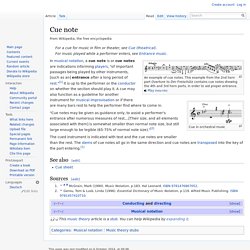
This example from the 2nd horn part Overture to Der Freischütz contains cue notes showing the 4th and 3rd horn parts, in order to aid proper entrance. Play "Cue notes may be given as guidance only, to assist a performer's entrance after numerous measures of rest.... [Their size, and all elements associated with them] is somewhat smaller than normal note size, but still large enough to be legible (65-75% of normal note size). Meter (music) Metric levels: beat level shown in middle with division levels above and multiple levels below.
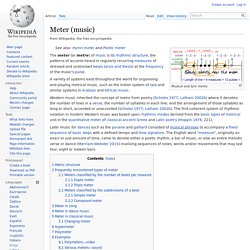
Main article: Duple meter Main article: Triple metre Triple meter is a meter in which each measure is divided into three beats, or a multiple thereof. For example, in the time signature 3/4, each measure contains three (3) quarter-note (4) beats, and with a time signature of 9/8, each measure contains three dotted-quarter beats. Simple meter and compound meter are distinguished by the way the beats are subdivided. Transposing instrument. The B♭ clarinet is a transposing instrument.

A C in a score for B♭ clarinet (top) is not an instruction for the player to sound a certain note but to use a certain fingering which on a B♭ clarinet happens to sound a B♭ (bottom), hence the name of the instrument. The very same fingering on an A clarinet will sound an A and in a score for A clarinet will again be associated with a written C. For some instruments (e.g., the piccolo or the double bass), the sounding pitch is still a C, but in a different octave; these instruments are said to transpose "at the octave". Modus (medieval music) In medieval music theory, the Latin term modus (meaning "a measure", "standard of measurement", "quantity", "size", "length", or, rendered in English, mode) can be used in a variety of distinct senses.

The most commonly used meaning today relates to the organisation of pitch in scales. Other meanings refer to the notation of rhythms. Nonchord tone. Example of nonchord tones (in red) Play .

Chord and nonchord tones are defined by their membership in a chord: "The pitches which make up a chord are called chord-tones: any other pitches are called non-chord-tones. Diatonic function. Scale degree names[1] (C major scale Play ).
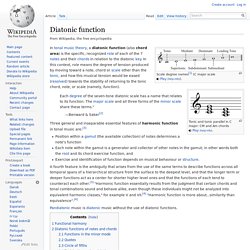
Tonic and tonic parallel in C major: CM and Am chords Play . Each degree of the seven-tone diatonic scale has a name that relates to its function. The major scale and all three forms of the minor scale share these terms. " Three general and inseparable essential features of harmonic function in tonal music are:[3] Pandiatonic music is diatonic music without the use of diatonic functions. Functional harmony[edit] The term functional harmony derives from Hugo Riemann and his textbooks on harmony in the late 19th century, with roots back to Jean-Philippe Rameau's theoretical works amongst others. Nonfunctional harmony, the opposite of functional harmony, is harmony whose progression is not guided by function. Diatonic functions of notes and chords[edit] The seven scale degrees in C major with their respective triads and Roman numeral notation In music theory, as it is commonly taught in the US, there are seven different functions.
As d'Indy summarizes: Mode (music) Modern Dorian mode on C Play Early Greek treatises on music do not use the term "mode" (which comes from Latin), but do describe three interrelated concepts that are related to the later, medieval idea of "mode": (1) scales (or "systems"), (2) tonos—pl. tonoi—(the more usual term used in medieval theory for what later came to be called "mode"), and (3) harmonia (harmony)—pl. harmoniai—this third term subsuming the corresponding tonoi but not necessarily the converse (Mathiesen 2001a, 6(iii)(e)).
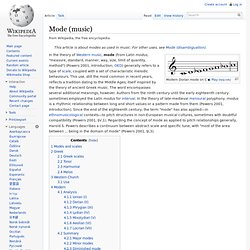
Greek Dorian octave species in the enharmonic genus, showing the two component tetrachords Play Greek Dorian octave species in the chromatic genus. Orchestration. Orchestration is the study or practice of writing music for an orchestra (or, more loosely, for any musical ensemble) or of adapting for an orchestra music composed for another medium.
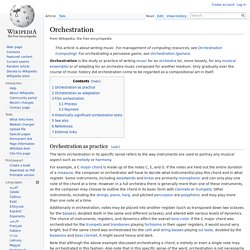
Only gradually over the course of music history did orchestration come to be regarded as a compositional art in itself. Orchestration as practice[edit] The term orchestration in its specific sense refers to the way instruments are used to portray any musical aspect such as melody or harmony. Additionally in orchestration, notes may be placed into another register (such as transposed down two octaves for the basses), doubled (both in the same and different octaves), and altered with various levels of dynamics. The choice of instruments, registers, and dynamics affect the overall tone color.